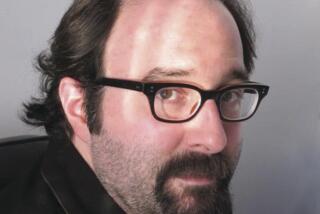Cartoons Reflect Soviet Recognition Cold War Is Over
- Share via
MOSCOW — For most of the last five decades, evil figures glared out from the massive display windows of a children’s library in central Moscow.
Among the frightful cartoon characters were crazed American generals with blood dripping from their bony fingers and top-hatted capitalists with protruding bellies.
Young Muscovites were expected to shudder at hideous depictions of Western politicians--Ronald Reagan as a demon king and Margaret Thatcher as a cackling, warmongering witch.
Ever present were “German revanchists”--Bonn leaders clad in iron helmets demanding revenge for defeat in World War II and cheered on by a skeletal Adolf Hitler.
Today, the villains in the windows are drawn from real Soviet life while U.S. generals and foreign capitalists are welcome guests in a country opening wide to the world.
Formally declared over last December by Presidents Mikhail S. Gorbachev and Bush, the Cold War and its trappings are gone from the Soviet scene.
With the end of the division of Germany formally sanctioned by the anti-Nazi wartime allies, the great symbol of the long and bitter confrontation between East and West has vanished.
For the first time since World War II, the Soviet Union and the United States have declared themselves--in the Persian Gulf crisis--on the same side of the barricades against a third state.
The significance of the joint stand against Iraq has not been lost on commentators in the Soviet media, who are now largely free from the blinders imposed by the old “ideological struggle.”
Five years ago, said Stanislav Kondrashov of the government daily Izvestia, the dispatch of U.S. forces to the Persian Gulf would have been denounced as aggression whatever its reason.
Now, said Leonid Mlechin of the weekly New Times, “Moscow has called an aggressor a state that in the past would have enjoyed our complete and unconditional support.”
Even the cartoonists have followed the new path. At their Sept. 9 summit in Helsinki, Gorbachev presented Bush with a drawing showing them as boxers knocking out the Cold War.
Its author, septuagenarian Mark Aldanov, was for years the creator of some of the most stridently anti-Western caricatures in the Soviet press.
The reversal was brought about by the “new thinking” proclaimed by Gorbachev after he came to power in 1985, although it coincided with a growing mood in the outside world favoring an end to the long East-West standoff.
During an earlier thawing of the Cold War ice in the early 1970s, Kremlin leader Leonid I. Brezhnev established a good rapport with President Richard M. Nixon.
But Soviet ideologists, and Brezhnev himself, insisted throughout that there could be no compromise on basic issues and that “detente” was the “international class struggle under another name.”
Gorbachev took the dramatic step of recognizing that perhaps Moscow was not always right. “New thinking” dropped “class positions” in international relations and focused on “common human values.”
Under the “class approach,” championed until his political demise this summer by Gorbachev’s one-time number two, Yegor Ligachev, “capitalist” countries could be right only if they agreed with the Soviet Union, the “workers’ state.”
“New thinking” recognizes that the behavior of the West toward Moscow depends on how Moscow itself behaved.
Applied to the history of relations between the Soviet Union and the outside world, it has increasingly brought some startling re-evaluations.
Moscow historians now frankly admit that the Korean War of 1950-53, the first great conflict of the Cold War, was launched not from the South, as the Kremlin always asserted, but by the North--with the encouragement of Josef Stalin.
“This war,” wrote Sergei Volovets in the journal Rodina, “was a wild gamble and a crime.”
Increasingly, Soviet researchers recognize that Western hostility toward the state born of the 1917 Bolshevik Revolution arose from its own declared conviction that it would, as Nikita S. Khrushchev once said, “bury you.”
The “Red Terror” of 1918-1919 and the murder of the entire Russian royal family--now widely recognized in Moscow as another crime--shaped the attitudes of millions across the globe toward the new state, and toward communism itself.
“For 70 years we lived on myths,” said writer Ales Adamovich, “and now these myths have fallen apart like a rotten piece of cloth.”
Could the Cold War revive? A gloomy scenario outlined recently by journalist Vladimir Sokolov, an editor of the weekly Literary Gazette, suggested it could.
A possible outcome of the Soviet Union’s current social turmoil, he said, is a takeover by hard-line army leaders in alliance with ultra-conservative politicians who would have to justify their destruction of reform by resurrecting the myth of a threat from the West.
But few political or intellectual figures appear to believe that such a coup, even if it occurred, could succeed.
“We now recognize that we turned down a blind historical alley in October, 1917,” said historian and former Communist Party official Alexander Tsipko. “We are now turning back to the high road.”
More to Read
Sign up for Essential California
The most important California stories and recommendations in your inbox every morning.
You may occasionally receive promotional content from the Los Angeles Times.













